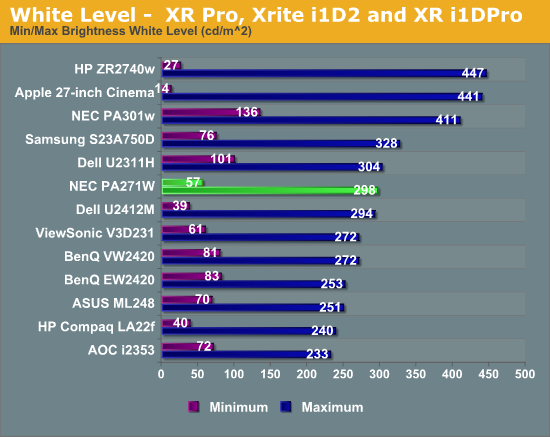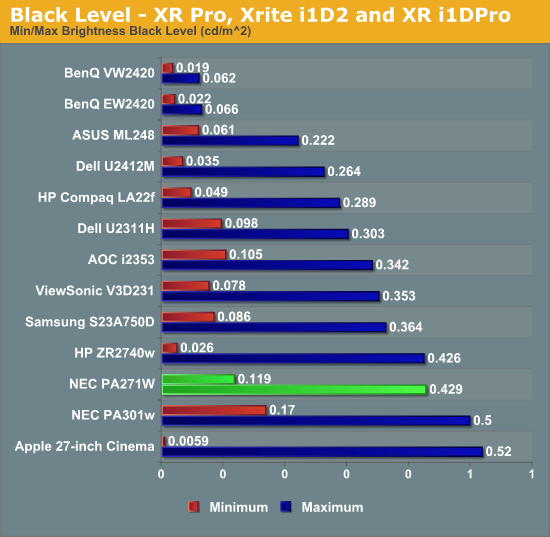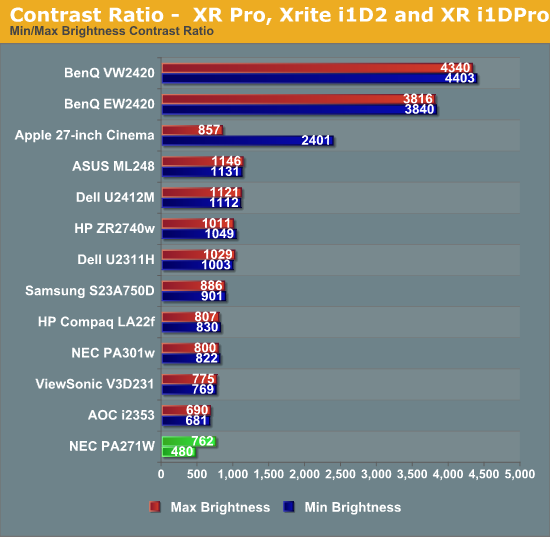NEC PA271W - When Accuracy and Consistency Matter
by Chris Heinonen on May 1, 2012 1:55 PM ESTNEC PA271W - Brightness and Contrast
The NEC is rated fairly conservatively at only 300 nits of light output at maximum, though for a professional work environment that is likely more than anyone would need. The OSD for the NEC lets you know the light output in cd/m^2 (which is equivalent to nits) as you raise and lower the value, and once you move past 250, the color changes to let you know you’re going beyond where the screen uniformity measurements can help you. Driven to the maximum output, the screen might read 400 cd/m^2 but the actual value was far less than that.

As we can see, we managed right around the maximum value of 300 nits, so that conservative estimate is right on in this case. The OSD might not indicate the correct value once you move past the recommended 250 cd/m^2 level, but below that it seemed to be within 3-4% of the listed value which was pretty good. You can see the lowest light output level was down to 57 nits, which means you can adjust the display to be dim enough for any work environment you might have.
Of course, with our accurate white levels we have to hope that we get good black levels as well, which has not been the high point for IPS screens with CCFL backlights, as opposed to LED dimming setups, in the past.

Unfortunately our black levels do leave a bit to be desired. The level at the minimum is 0.119, and I’d hope for something closer to 0.050 or less, and the maximum level was 0.429, which looks closer to a dark gray than black at that level. These indicate that our contrast ratio probably is going to leave a bit to be desired with the NEC.

As we could guess, the contrast ratio with the minimum backlight is only 480:1, and it rises up to 762:1 with the monitor at maximum output. With the wide swing between these two values I went ahead and measured the contrast ratio at our calibrated 200 nits setting and found it was 561:1, so the ratio improves as the light output level increases. It seems there is a minimum amount of light that the IPS panel is going to let through, which could be related to the screen uniformity technology used by NEC on the display, but you should be aware that if you want deep, dark blacks you’ll need to look for a different display using either a different panel technology, a different backlighting technology, or both.










69 Comments
View All Comments
sviola - Wednesday, May 2, 2012 - link
If it wasn't for LCDs, probably no one would have monitors/tvs bigger than 30" (and a CRT that size was huge and extremely heavy).DanNeely - Wednesday, May 2, 2012 - link
Rear projection TVs got into the 50/60" class.Mumrik - Wednesday, May 2, 2012 - link
And 32" was the standard size for a widescreen TV in the living room around here...ctbaars - Wednesday, May 2, 2012 - link
I remember the same kind of argument when we went from Vinyl to CD :/ I'm not quite buying it.Mumrik - Wednesday, May 2, 2012 - link
I'm still using a Sony FW900.To be honest, it's not in tip-top shape anymore - the picture could be sharper. I had hoped to be able to use it until OLED arrived in the mainstream (as it was supposed to do YEARS ago). At this point I'm starting to consider 24-27" IPS panels.
JohnMD1022 - Wednesday, May 2, 2012 - link
My NEC Multisync FE992 still performs flawlessly.When it begins to fail, I'll replace it.
Meanwhile, with each passing day, LCD technology improves and prices drop. :)
futrtrubl - Tuesday, May 1, 2012 - link
The numbers seem off for a couple of the displays with their minimum brightness settings drawing MORE power. That's the two NECs, the Apple and a Dell and BenQ.JarredWalton - Tuesday, May 1, 2012 - link
You are correct, sir! I've updated the chart so that the colors and min/max values are now correct.cheinonen - Tuesday, May 1, 2012 - link
Sorry about that, they got flipped in a version of the spreadsheet I use for the numbers and I thought they were fixed in the most recent one, but I'll update that again so it doesn't happen next time.asasa45454 - Tuesday, May 1, 2012 - link
Are you going to review them? They have input lag ~10ms, 2560x1440.